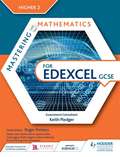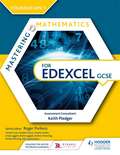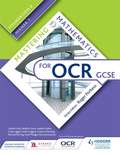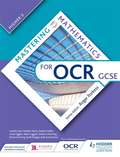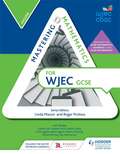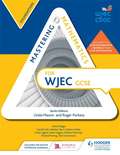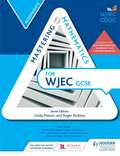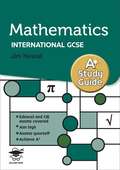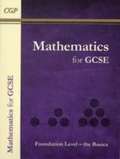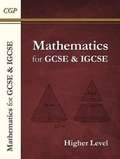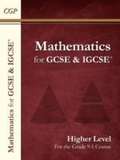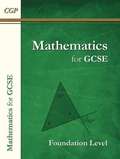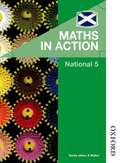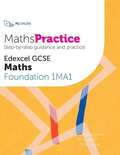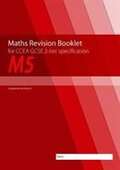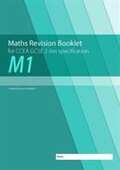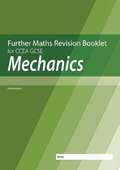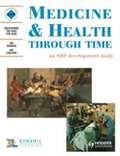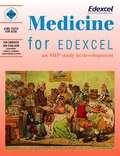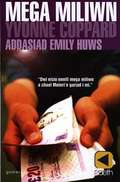- Table View
- List View
Mastering Mathematics for Edexcel GCSE: Higher 2 (PDF)
by Hodder EducationHelp students to develop their knowledge, skills and understanding so that they can reason mathematically, communicate mathematical information and apply mathematical techniques in solving problems; with resources developed specifically for the Edexcel GCSE 2015 specification with leading Assessment Consultant Keith Pledger and a team of subject specialists. - Supports you and your students through the new specifications, with topic explanations and new exam-style questions, to support the new assessment objectives. - Builds understanding and measures progress throughout the course with plenty of graduated exercises and worked examples. - Organises topics into progression strands, enabling you and your students to identify gaps in learning and apply appropriate remediation or extension steps in order to make the best progress. - Provides full coverage of the GCSE grade range with three books, meaning that content is focused at the right level for each student. - Offers a seamless five year progression when used in conjunction with KS3 Mastering Mathematics.
Mastering Mathematics for Edexcel GCSE: Foundation 1 (PDF)
by Sophie Goldie Robin Ligett Andrew Manning Heather Davis Linda Liggett Colin WhiteHelp students to develop their knowledge, skills and understanding so that they can reason mathematically, communicate mathematical information and apply mathematical techniques in solving problems; with resources developed specifically for the Edexcel GCSE 2015 specification with leading Assessment Consultant Keith Pledger and a team of subject specialists. - Supports you and your students through the new specifications, with topic explanations and new exam-style questions, to support the new assessment objectives. - Builds understanding and measures progress throughout the course with plenty of graduated exercises and worked examples. - Organises topics into progression strands, enabling you and your students to identify gaps in learning and apply appropriate remediation or extension steps in order to make the best progress. - Provides full coverage of the GCSE grade range with three books, meaning that content is focused at the right level for each student. - Offers a seamless five year progression when used in conjunction with KS3 Mastering Mathematics.
Mastering Mathematics for OCR GCSE: Foundation 2/Higher 1 (PDF)
by Gareth ColeBuild your students' knowledge and understanding so that they can confidently reason, interpret, communicate mathematically and apply their mathematical skills to solve problems within mathematics and wider contexts; with resources developed specifically for the OCR GCSE 2015 specification by mathematics subject specialists experienced in teaching and examining GCSE. - Supports you and your students through the new specifications, with topic explanations and new exam-style questions, written in line with the new assessment objectives.
Mastering Mathematics for OCR GCSE: Higher 2 (PDF)
by Gareth ColeBuild your students' knowledge and understanding so that they can confidently reason, interpret, communicate mathematically and apply their mathematical skills to solve problems within mathematics and wider contexts; with resources developed specifically for the OCR GCSE 2015 specification by mathematics subject specialists experienced in teaching and examining GCSE. - Supports you and your students through the new specifications, with topic explanations and new exam-style questions, written in line with the new assessment objectives.
Mastering Mathematics for WJEC GCSE: Higher (PDF)
by Mason, Linda: Porkess, RogerHelp students get to grips with the new style examinations in Numeracy and Mathematics with books that build all the necessary skills to progress their learning and develop their problem-solving skills. - Provides one book for each tier ensuring full coverage, with mathematics only questions and chapters clearly highlighted so the specifications can be co-taught or taught separately as required - Organises topics into units so as to provide questions that build understanding and fluency enabling students to confidently tackle and solve real and interesting problems - Enables students to identify the appropriate remediation or extension steps they need in order to make the best progress, through easy to follow progression strands that help to identify gaps in learning - Offers a seamless five year progression when used in conjunction with KS3 Mastering Mathematics
Mastering Mathematics for WJEC GCSE: Foundation (PDF)
by Roger PorkessHelp students get to grips with the new style examinations in Numeracy and Mathematics with books that build all the necessary skills to progress their learning and develop their problem-solving skills. - Provides one book for each tier ensuring full coverage, with mathematics only questions and chapters clearly highlighted so the specifications can be co-taught or taught separately as required - Organises topics into units so as to provide questions that build understanding and fluency enabling students to confidently tackle and solve real and interesting problems - Enables students to identify the appropriate remediation or extension steps they need in order to make the best progress, through easy to follow progression strands that help to identify gaps in learning - Offers a seamless five year progression when used in conjunction with KS3 Mastering Mathematics
Mastering Mathematics for WJEC GCSE: Intermediate (PDF)
by Roger PorkessHelp students get to grips with the new style examinations in Numeracy and Mathematics with books that build all the necessary skills to progress their learning and develop their problem-solving skills. - Provides one book for each tier ensuring full coverage, with mathematics only questions and chapters clearly highlighted so the specifications can be co-taught or taught separately as required - Organises topics into units so as to provide questions that build understanding and fluency enabling students to confidently tackle and solve real and interesting problems - Enables students to identify the appropriate remediation or extension steps they need in order to make the best progress, through easy to follow progression strands that help to identify gaps in learning - Offers a seamless five year progression when used in conjunction with KS3 Mastering Mathematics
Mathematics: A* Study Guide for International GCSE (PDF)
by Jim NewallThis book provides a basis for revision for International GCSE Mathematics exams, offering a concise but rigorous presentation of the facts.
Mathematics for GCSE: Foundation Level - The Basics (PDF)
by Cgp BooksThis full-colour book contains thousands of practice questions for Foundation Level GCSE Maths - it's ideal for less confident students (working towards grades D-G).
Mathematics for GCSE and IGCSE: Higher Level (PDF)
by Cgp BooksThis book contains thousands of practice questions comprehensively covering every Higher Level GCSE and IGCSE Maths course - ideal for mastering all the important maths techniques.
Maths for GCSE and IGCSE® Textbook, Higher (for the Grade 9-1 Course) (2016 Version)
by Cgp Books"This superb Textbook is bursting with thousands of practice questions for Higher Level GCSE and IGCSE Maths. It's a fantastic source of classwork and homework throughout the course, with answers included at the back of the book! For each topic, there are worked examples that show students how to approach problems step-by-step, followed by a huge number of questions that build up in difficulty as they gain confidence. And if you'd rather not hand out the printed books for homework, there's a brilliant Online Edition that students can read on a PC, Mac or tablet. There's also a money-saving bundle containing a printed Textbook and two Online Editions!
Maths for GCSE and IGCSE® Textbook: Higher - includes Answers
by Cgp BooksThis chunky CGP Textbook contains thousands of practice questions (with answers) comprehensively covering Higher Level Grade 9-1 GCSE Maths and IGCSE Maths. For each topic, there are worked examples that show students how to approach problems step-by-step, followed by a huge number of questions that build up in difficulty as they gain confidence. This book is also available as an Online Edition for PC, Mac and tablets - see 9781782944584.
Maths for GCSE, Foundation Level (PDF)
by Cgp BooksThis book contains thousands of practice questions comprehensively covering every Foundation Level GCSE Maths course. For each topic, there are worked examples that show students how to approach problems step-by-step, followed by a huge number of questions that build up in difficulty as they gain confidence. All the answers are included at the back of the book.
Maths in Action: National 5 (PDF)
by J Mclaughlin E Mullan R Howat E Varrie G Melkle D MurrayWritten by trusted experts, this book includes all the best bits teachers love about 'Maths in Action', now tailored to pupils of all ability who are studying for this qualification, and supports the new assessment requirements.
Maths Practice Edexcel GCSE Maths Foundation 1ma1
by B. Cottingham R. Huntley A. LutwycheOver 1500 practice and examination style questions Answers provided for all questions within the book. Clean illustrations to improve memory and recall. Specification references for every topic. Examination tips and techniques. Absolute clarity is the aim with a new generation of practice and revision guide for maths. This clear study guide has been expertly compiled and edited by subject specialists, highly experienced examiners and a good dollop of scientific research into what makes revision most effective. Past examination questions are essential to good preparation, improving understanding and confidence. This comprehensive guide has combined step-by-step exemplar exercises with progressively more complex questions to test and hone your understanding of every topic. Designed for use in class or for revision, this slimline guide includes tips and more practice questions than you could shake a stick at. All the essential ingredients for getting a grade you can be really proud of. Each specification topic has been referenced and distilled into the key points to help you get top marks in the examination.
Mechanics 1 For Edexcel (PDF)
by The School Mathematics ProjectBased on extensive feedback from teachers, these popular A Level titles have been written by the experienced team that produced SMP Interact for GCSE. These are clear, user-friendly texts that both teacher and student will enjoy using. Each chapter's objectives are clearly set out and new concepts are carefully developed in a way that involves the student. Worked examples are designed to clarify ideas and techniques, and there is plenty of well-graded practice and revision, including past exam questions that show the standard required. Key points are highlighted as they arise and are gathered in a summary at the end of the chapter, where there is also a self-assessment section. Each book contains a detailed contents analysis and the chapters are structured so that you can easily tell what part of the specification you are covering. Opportunities for classroom discussion are marked, and starred questions provide extra challenge where needed.
Medicine and Health Through Time: a development study (PDF)
by Ian Coulson Ian Dawson Schools History ProjectMedicine and Health Through time is an authoritative SHP development study for use with all GCSE specifications from all examinations boards. It thoroughly covers the content requirements of the OCR, Edexcel and AQA SHP specifications using an enquiry based approach. It is written by experts who understand both how to design good teaching material but also understand the exact assessment requirements of each specification.
Medicine for Edexcel: An SHP Study in Development (PDF)
by Dawson, Ian, Coulson, IanA comprehensive course book for Edexcel's SHP Development Study. The course takes a chronological approach to the content. It combines Edexcel's core content:
Mega Miliwn (Saeth)
by Yvonne Coppard Emily HuwsAddasiad Cymraeg o To Be a Millionaire, stori gyfoes ddifyr am obeithion a chynlluniau gwallgof llanc ifanc i ddod yn filiwnydd trwy actio mewn ffilm, ac i ennill cariad. Nofer fer wedi'i hysgrifennu mewn iaith syml ar gyfer darllenwyr anfoddog yn sôn am bynciau cyfoes o ddiddordeb i ddisgyblion tua 13-16 oed. [A Welsh adaptation of To Be a Millionaire, an entertaining modern story about a youth's hopes and hilarious plans of becoming a millionaire by acting in a film, and of gaining a girlfriend. A short novel written in plain language suitable for reluctant readers discussing contemporary issues of interest to 13-16 year-old pupils.] *Datganiad hawlfraint Gwneir y copi hwn dan dermau Rheoliadau (Anabledd) Hawlfraint a Hawliau mewn Perfformiadau 2014 i'w ddefnyddio gan berson sy'n anabl o ran print yn unig. Oni chaniateir gan gyfraith, ni ellir ei gopïo ymhellach, na'i roi i unrhyw berson arall, heb ganiatâd.
Meiosis phase one (Large Print)
by Rnib BookshareThese pages show late interphase before meiosis, and five stages of meiosis phase one. There is a locator dot shown on each page, which will be at the top left of the page when the image is the correct way up. Meiosis is cell replication where a cell divides to produce four non-identical gametes, each with only one set of chromosomes instead of the usual two sets found in all other cells.Late interphase before meiosis. This page shows a cell immediately before meiosis starts. The cell is a large rounded shape in the centre of the page. Its nucleus fills the bottom of the cell and two centrioles are in the top of the cell. The twenty three pairs of chromosomes in the nucleus have replicated to form a mass of chromatids (double chromosomes) which are tightly coiled. Note the size of the nucleus and the centrioles in relation to the overall size of the cell are greatly enlarged for clarity. Only some of the chromatin is shown, also for clarity. Meiosis - stage one, early prophase I. This page shows the start of meiosis. The cell is in the centre of the page. In the top of the cell the centrioles to the left and right have the mitotic spindle growing between them. The nucleus shows two chromatids - the double chromosomes. The ends of the chromosomes of the chromatids are crossed in two places, to the top and bottom of the pair. In reality in humans there would be twenty three pairs of chromatids.Meiosis - stage one, late prophase I. This page shows chromatids after crossover. The cell is in the centre of the page. In the top of the cell the centrioles to the left and right have the mitotic spindle growing between them. The nucleus shows two chromatids - the double chromosomes. The ends of the chromosomes of the chromatids have swapped DNA coding where they were crossed. The ends to the top centre of the chromatids have swapped and the ends of the other pair of chromosomes to the bottom centre have also swapped.Meiosis - stage two, metaphase I. This page shows the completed mitotic spindle with a centriole to the left and right. The nuclear envelope has disappeared. The chromatids have attached themselves side by side to the centre of the spindle on the central microtubule by their centromeres in the centre of the image. For clarity other chromatids are not shown so the microtubule to the top and bottom of the image appears empty. In reality there would be many more pairs of chromatids and microtubules.Meiosis - stage three, anaphase I. This page shows the centromeres have separated. The microtubules of the spindle are retracting to the left and right. Each chromatid of the pair of chromosomes are migrating to opposite ends of the spindle to the left and right.Meiosis - stage four, telophase I. This page shows centrioles to the left and to the right. One chromatid is in the left and one chromatid is in the right of the cell. To the top and bottom centre of the cell the plasma membrane is pinching in and starting to divide the cytoplasm.
Meiosis phase one (UEB Uncontracted)
by Rnib BookshareThese pages show late interphase before meiosis, and five stages of meiosis phase one. There is a locator dot shown on each page, which will be at the top left of the page when the image is the correct way up. Meiosis is cell replication where a cell divides to produce four non-identical gametes, each with only one set of chromosomes instead of the usual two sets found in all other cells.Late interphase before meiosis. This page shows a cell immediately before meiosis starts. The cell is a large rounded shape in the centre of the page. Its nucleus fills the bottom of the cell and two centrioles are in the top of the cell. The twenty three pairs of chromosomes in the nucleus have replicated to form a mass of chromatids (double chromosomes) which are tightly coiled. Note the size of the nucleus and the centrioles in relation to the overall size of the cell are greatly enlarged for clarity. Only some of the chromatin is shown, also for clarity. Meiosis - stage one, early prophase I. This page shows the start of meiosis. The cell is in the centre of the page. In the top of the cell the centrioles to the left and right have the mitotic spindle growing between them. The nucleus shows two chromatids - the double chromosomes. The ends of the chromosomes of the chromatids are crossed in two places, to the top and bottom of the pair. In reality in humans there would be twenty three pairs of chromatids.Meiosis - stage one, late prophase I. This page shows chromatids after crossover. The cell is in the centre of the page. In the top of the cell the centrioles to the left and right have the mitotic spindle growing between them. The nucleus shows two chromatids - the double chromosomes. The ends of the chromosomes of the chromatids have swapped DNA coding where they were crossed. The ends to the top centre of the chromatids have swapped and the ends of the other pair of chromosomes to the bottom centre have also swapped.Meiosis - stage two, metaphase I. This page shows the completed mitotic spindle with a centriole to the left and right. The nuclear envelope has disappeared. The chromatids have attached themselves side by side to the centre of the spindle on the central microtubule by their centromeres in the centre of the image. For clarity other chromatids are not shown so the microtubule to the top and bottom of the image appears empty. In reality there would be many more pairs of chromatids and microtubules.Meiosis - stage three, anaphase I. This page shows the centromeres have separated. The microtubules of the spindle are retracting to the left and right. Each chromatid of the pair of chromosomes are migrating to opposite ends of the spindle to the left and right.Meiosis - stage four, telophase I. This page shows centrioles to the left and to the right. One chromatid is in the left and one chromatid is in the right of the cell. To the top and bottom centre of the cell the plasma membrane is pinching in and starting to divide the cytoplasm.
Meiosis Phase One (UEB Uncontracted)
by RnibThese pages show late interphase before meiosis, and five stages of meiosis phase one. There is a locator dot shown on each page, which will be at the top left of the page when the image is the correct way up. Meiosis is cell replication where a cell divides to produce four non-identical gametes, each with only one set of chromosomes instead of the usual two sets found in all other cells.Late interphase before meiosis. This page shows a cell immediately before meiosis starts. The cell is a large rounded shape in the centre of the page. Its nucleus fills the bottom of the cell and two centrioles are in the top of the cell. The twenty three pairs of chromosomes in the nucleus have replicated to form a mass of chromatids (double chromosomes) which are tightly coiled. Note the size of the nucleus and the centrioles in relation to the overall size of the cell are greatly enlarged for clarity. Only some of the chromatin is shown, also for clarity. Meiosis - stage one, early prophase I. This page shows the start of meiosis. The cell is in the centre of the page. In the top of the cell the centrioles to the left and right have the mitotic spindle growing between them. The nucleus shows two chromatids - the double chromosomes. The ends of the chromosomes of the chromatids are crossed in two places, to the top and bottom of the pair. In reality in humans there would be twenty three pairs of chromatids.Meiosis - stage one, late prophase I. This page shows chromatids after crossover. The cell is in the centre of the page. In the top of the cell the centrioles to the left and right have the mitotic spindle growing between them. The nucleus shows two chromatids - the double chromosomes. The ends of the chromosomes of the chromatids have swapped DNA coding where they were crossed. The ends to the top centre of the chromatids have swapped and the ends of the other pair of chromosomes to the bottom centre have also swapped.Meiosis - stage two, metaphase I. This page shows the completed mitotic spindle with a centriole to the left and right. The nuclear envelope has disappeared. The chromatids have attached themselves side by side to the centre of the spindle on the central microtubule by their centromeres in the centre of the image. For clarity other chromatids are not shown so the microtubule to the top and bottom of the image appears empty. In reality there would be many more pairs of chromatids and microtubules.Meiosis - stage three, anaphase I. This page shows the centromeres have separated. The microtubules of the spindle are retracting to the left and right. Each chromatid of the pair of chromosomes are migrating to opposite ends of the spindle to the left and right.Meiosis - stage four, telophase I. This page shows centrioles to the left and to the right. One chromatid is in the left and one chromatid is in the right of the cell. To the top and bottom centre of the cell the plasma membrane is pinching in and starting to divide the cytoplasm.
